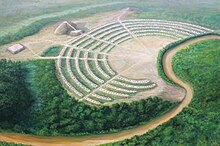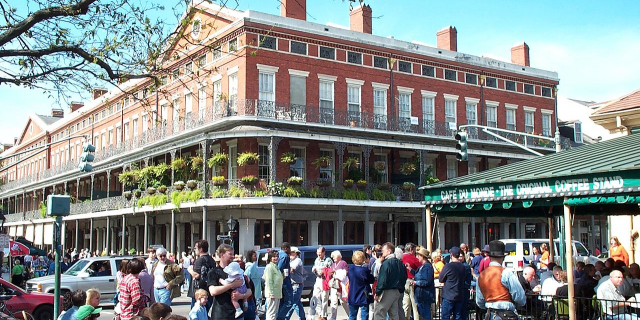Poverty Point
Poverty Point State Historic Site/Poverty Point National Monument (French: Pointe de Pauvreté; 16 WC 5) is a prehistoric earthwork constructed by the Poverty Point culture, located in present-day northeastern Louisiana. Evidence of the Poverty Point culture extends throughout much of the Southeastern Woodlands of the Southern United States. The culture extended 100 miles (160 km) across the Mississippi Delta and south to the Gulf Coast.
The Poverty Point site has been designated as a state historic site, U.S. National Monument, a U.S. National Historic Landmark, and UNESCO World Heritage Site. The site is 15.5 miles (24.9 km) from the current flow of the Mississippi River, and is situated on the edge of Macon Ridge. The village of Epps developed in the historic period in West Carroll Parish, Louisiana.
The Poverty Point site contains earthen ridges and mounds, built by indigenous people between 1700 and 1100 BCE dur...Read more
Poverty Point State Historic Site/Poverty Point National Monument (French: Pointe de Pauvreté; 16 WC 5) is a prehistoric earthwork constructed by the Poverty Point culture, located in present-day northeastern Louisiana. Evidence of the Poverty Point culture extends throughout much of the Southeastern Woodlands of the Southern United States. The culture extended 100 miles (160 km) across the Mississippi Delta and south to the Gulf Coast.
The Poverty Point site has been designated as a state historic site, U.S. National Monument, a U.S. National Historic Landmark, and UNESCO World Heritage Site. The site is 15.5 miles (24.9 km) from the current flow of the Mississippi River, and is situated on the edge of Macon Ridge. The village of Epps developed in the historic period in West Carroll Parish, Louisiana.
The Poverty Point site contains earthen ridges and mounds, built by indigenous people between 1700 and 1100 BCE during the Late Archaic period in North America. Archaeologists have proposed a variety of possible functions for the site, including as a settlement, a trading center, and/or a ceremonial religious complex.
The 402-acre (163 ha) property now operated as the Poverty Point State Historic Site contains "the largest and most complex Late Archaic earthwork occupation and ceremonial site yet found in North America". Euroamericans described the site in the 19th century. Since the 1950s Poverty Point has been the focus of professional archaeological excavations. The earthworks are named after a 19th-century plantation on the property.
 Barrels outline circular structures in the 37.5-acre (17.4 ha) plaza at Poverty Point
Barrels outline circular structures in the 37.5-acre (17.4 ha) plaza at Poverty PointPoverty Point was not constructed all at once. The final form appears to have been the product of successive generations over a considerable period of time. The exact sequence and timeframe of earthwork construction is not precisely known. Radiocarbon dating of the site has produced a wide variety of results, but recent syntheses suggest earthwork construction began as early as 1800 BCE and continued until as late as 1200 BCE.[1][2][3]
Archaeological excavations determined that prior to the construction of the earthworks, prehistoric workers leveled the land around the site and filled in gullies and other low places to create the flat central plaza and surfaces on which to build the mounds and ridges. The main building material was loess, a type of silt loam soil which is easy to dig but erodes when exposed to water. For this reason, clay may have been used to cap the loess constructions to protect the surfaces from erosion.[4] The earthworks were constructed by dumping basket loads of dirt in piles and then filling in the gaps between them. The baskets, depending on the size of the bearer, could hold between 30–50 lb (13.6–22.7 kg) of dirt, suggesting that men, women, and children participated in the construction.[5]
The number of individuals involved in the construction of Poverty Point is unknown, although archaeologist Jon L. Gibson provides multiple scenarios for how long it would have taken to build the earthwork depending on the number and intensity of individual efforts. For example, he estimated that the earthwork could have been produced in a century by three generations if one hundred individuals spent six or seven days a month on the construction project. Gibson also suggests that workers lived on-site during construction, possibly setting up temporary homes on top of the very earthworks that they were building.[6] Most archaeological excavations of the ridges at Poverty Point consist of small 3.3 ft × 3.3 ft (1 m × 1 m) units that cannot reveal the extent of an entire household. An exception is the 1980–1982 Louisiana State University excavations that explored a 16 ft × 98 ft (4.9 m × 29.9 m) trench placed on the Northwest Ridge 1. The trench excavation revealed multiple sequential levels of domestic activity over time. Archaeologists have interpreted this zone as possible evidence for more long-term habitation of the site.[7]
Changes in temperature, precipitation, and increased flooding, may have caused an ecological imbalance that led to the abandonment of Poverty Point. Archeologists use this change as a time boundary between the Archaic and later Woodland periods. [8]
Purposes Artist's conception of the completely constructed site.
Artist's conception of the completely constructed site.Archaeologists have long debated the functions of the Poverty Point site. One of the main questions has been whether it was used for a settlement or only for periodic events. Archaeologists postulate that houses were constructed on top of the concentric ridges. Postholes along with hearths and earth ovens have been found on the ridges, indicating the presence of buildings and associated activities. Other archaeologists believe that regular residence would have produced more postholes. Gibson and others note the postholes could have been destroyed by the historic plowing that took place on much of the site and also note the limited excavations that would reveal posthole patterns of houses.[9]
Archaeologists such as Sherwood Gagliano and Edwin Jackson support the interpretation that Poverty Point was a site where groups came to meet and trade on an occasional basis.[10] Gibson believes there is evidence of too much rubbish left by original inhabitants for only occasional habitation, and that it would be implausible to build such a massive earthwork for use only as a trading center.[11]
Some archaeologists interpret Poverty Point as having religious symbolism and importance. Archaeologist William Haag, who excavated at the site in the 1970s, interpreted the aisles that divide the ridge sectors as having astronomical significance aligned to the solstices.[12] Astronomer Robert Purrington believes the ridges at Poverty Point were geometrically, rather than astronomically, aligned.[13] The discrepancy between Haag and Purrington's conclusions stems from having chosen different centers for the site, leading to different angles for the aisles.[12] Researchers have also studied historic and contemporary Native American religious beliefs for parallels. Gibson believes that the ridges were built with their arcs against the west to keep malevolent spirits of evil and death out of the complex.[14]
Poverty Point people Decorative objects formed from loess soil, then fired, found at the Poverty Point site
Decorative objects formed from loess soil, then fired, found at the Poverty Point siteThe people of the Poverty Point culture who constructed the earthworks were hunter-fisher-gatherers rather than agriculturalists. They are an example of a complex hunter-gatherer society that constructed large-scale monuments. The vast majority of other prehistoric monuments, ranging from Stonehenge in England to Khufu's Great Pyramid at Giza in Egypt, were constructed by agricultural societies, in which crop surpluses allowed greater density of population and stratification of society.[citation needed]
The people who lived at Poverty Point were Native Americans, descendants of the immigrants who came to North America across the Bering Strait land bridge approximately 20,000 to 23,000 years ago. The people identified with the Poverty Point culture developed a distinct set of cultural traits different from other contemporary inhabitants in the Lower Mississippi Valley.[15] Time, cultural change, and the lack of written records prevent researchers from identifying the people of Poverty Point as ancestors to any specific historic or modern tribe.
The food sources of the people at Poverty Point came from the local animals and plant life in the region. The Poverty Point people's food was acquired through fishing, gathering, and hunting. Poverty Point subsistence was broad-based due to the different seasonal foods that were available. Their diet consisted of large mammals like deer, small mammals like possum, various fish and turtles, mollusks, nuts, fruits, berries, and aquatic roots.[16]
Artifacts Museum at Poverty Point
Museum at Poverty PointThe vast majority of artifacts recovered at Poverty Point are small, baked shapes made of loess, found in a wide variety of forms and referred to as "Poverty Point Objects" or PPOs.[17] Except for unique specialized forms, archaeologists generally conclude the fired earth objects were used in cooking, based on the artifacts recovery context and supported by experimental archaeology. When placed in earth ovens, the objects were shown to hold heat and aid in cooking food.[18]
The inhabitants of Poverty Point produced small amounts of pottery, creating a variety of different types such as fiber-tempered, grog-tempered, and untempered with both the Wheeler and Old Floyd Tchefuncte design styles as decoration.[19] More commonly, however, they imported stone vessels from other peoples, made of steatite from the foothills of the Appalachian Mountains.[20]
Most of the Poverty Point tools appear to have been made on-site, as there is evidence of debris from their manufacturing process found across the ridges.[21] An analysis of artifacts recovered from the ridges demonstrates that individual ridges and sectors of the earthwork complex were used for specialized activities. For example, based on the analysis of projectile points and production debris, the north sector of the earthwork was the favored location for manufacturing tools and the South sectors were the location where the manufactured projectile points were used as tools. Beads, pendants and other lapidary items were recovered primarily in the West sector. However, clay figurines are evenly distributed throughout the ridge system.[17] Based on the analysis of artifacts recovered from successive strata of ridge construction, there are clear changes in artifact styles through time. For example, cylindrical grooved Poverty Point Objects are the earliest form of the artifact type produced and biconical forms occur later in time.[7]
There is no naturally occurring stone at Poverty Point. Based on the distant geological sources of different kinds of stone used to make lithic artifacts recovered at Poverty Point, archaeologists conclude that the inhabitants were active in trade with other Native Americans. For example, a disproportionate number of projectile points were made from raw materials naturally occurring in the Ouachita and Ozark mountains, and in the Ohio and Tennessee river valleys. Other materials derived from trade included soapstone from the southern Appalachian Mountains of Alabama and Georgia, and galena from Missouri and Iowa. Archaeologists assumed that the presence of copper artifacts indicated trade with copper-producing tribes in the upper Great Lakes region.[22] However, modern scientific analyses demonstrate that at least some of the copper artifacts recovered from Poverty Point were made from materials available in the southern Appalachian Mountains, where soapstone or steatite vessels at Poverty Point are also sourced.[23]



































Add new comment